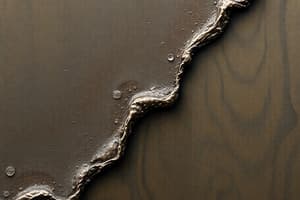Podcast
Questions and Answers
What type of bond is characteristic of ceramics?
What type of bond is characteristic of ceramics?
- Covalent bond
- Ionic bond (correct)
- Metallic bond
- Hydrogen bond
What is the point where a material exceeds its elastic limit and begins permanent deformation called?
What is the point where a material exceeds its elastic limit and begins permanent deformation called?
- Plastic flow (correct)
- Elastic limit
- Fracture point
- Yield point
What is the modulus of elasticity also known as?
What is the modulus of elasticity also known as?
- Shear modulus
- Young's modulus (correct)
- Tensile modulus
- Bulk modulus
What mechanical property refers to the ability of a material to resist the propagation of a preformed crack?
What mechanical property refers to the ability of a material to resist the propagation of a preformed crack?
In which type of bond are metals characterized?
In which type of bond are metals characterized?
What is the fractional change in dimensions caused by force known as?
What is the fractional change in dimensions caused by force known as?
What will happen if a restoration is subjected to tensile stress exceeding the yield stress?
What will happen if a restoration is subjected to tensile stress exceeding the yield stress?
What type of bond characterizes molecular solids?
What type of bond characterizes molecular solids?
What is the ability of a material to resist deformation under tensile stress known as?
What is the ability of a material to resist deformation under tensile stress known as?
What type of bond characterizes polymers?
What type of bond characterizes polymers?
What is the ability of a material to resist deformation under compressive stress known as?
What is the ability of a material to resist deformation under compressive stress known as?
Which test measures the resistance of a material to an indenter or cutting tool?
Which test measures the resistance of a material to an indenter or cutting tool?
What property refers to the ease of heat transference through a material?
What property refers to the ease of heat transference through a material?
What type of corrosion involves the release of metal ions into a space, forming corrosion products, and is considered more dangerous than uniform corrosion?
What type of corrosion involves the release of metal ions into a space, forming corrosion products, and is considered more dangerous than uniform corrosion?
Which property indicates the amount of plastic strain produced in a specimen at the point of fracture?
Which property indicates the amount of plastic strain produced in a specimen at the point of fracture?
What type of test subjects materials to fluctuating stresses rather than static loads?
What type of test subjects materials to fluctuating stresses rather than static loads?
What property refers to the rate of rise of temperature at one point due to a heat source at another point?
What property refers to the rate of rise of temperature at one point due to a heat source at another point?
Which type of corrosion involves an electrochemical reaction between a material and its environment, leading to a decrease in free energy?
Which type of corrosion involves an electrochemical reaction between a material and its environment, leading to a decrease in free energy?
What property refers to the amount of energy a material can absorb without any permanent deformation?
What property refers to the amount of energy a material can absorb without any permanent deformation?
Which test measures the influence of constant stress that will eventually lead to material fracture?
Which test measures the influence of constant stress that will eventually lead to material fracture?
What property refers to the resistance of a material to an indenter or cutting tool?
What property refers to the resistance of a material to an indenter or cutting tool?
Which property refers to the ability of solids to rearrange molecules under an applied load?
Which property refers to the ability of solids to rearrange molecules under an applied load?
What type of corrosion involves the release of metal ions into water, and is characterized by the reaction of metal with the liquid?
What type of corrosion involves the release of metal ions into water, and is characterized by the reaction of metal with the liquid?
Which mechanical test is used to determine the resistance of a material to an indenter or cutting tool?
Which mechanical test is used to determine the resistance of a material to an indenter or cutting tool?
What property refers to the amount of energy a material can absorb without any permanent deformation?
What property refers to the amount of energy a material can absorb without any permanent deformation?
What property measures the stress required to break a material?
What property measures the stress required to break a material?
Which property refers to the maximum stress that a specimen can withstand before failure?
Which property refers to the maximum stress that a specimen can withstand before failure?
What type of stress is characterized by fluctuating stresses rather than static loads?
What type of stress is characterized by fluctuating stresses rather than static loads?
Which property measures the ease of heat transference through a material?
Which property measures the ease of heat transference through a material?
What property refers to the rate of rise of temperature at one point due to a heat source at another point?
What property refers to the rate of rise of temperature at one point due to a heat source at another point?
What type of corrosion is characterized by the release of metal ions into space forming corrosion products?
What type of corrosion is characterized by the release of metal ions into space forming corrosion products?
Which type of corrosion takes place in neutral, acid, or alkaline environments?
Which type of corrosion takes place in neutral, acid, or alkaline environments?
What is the property that allows passage of light in such a way that little distortion takes place?
What is the property that allows passage of light in such a way that little distortion takes place?
What property refers to the resistance of a material to an indenter or cutting tool?
What property refers to the resistance of a material to an indenter or cutting tool?
Which type of test measures the influence of constant stress that will eventually lead to material fracture?
Which type of test measures the influence of constant stress that will eventually lead to material fracture?
Flashcards
Thermal Conductivity
Thermal Conductivity
The ability of a material to conduct heat.
Ionic Bond
Ionic Bond
Ceramics are bonded together by this type of bond.
Crevice Corrosion
Crevice Corrosion
This type of corrosion involves the release of metal ions into a space, usually a crevice, forming corrosion products.
Strength
Strength
Signup and view all the flashcards
Covalent Bond
Covalent Bond
Signup and view all the flashcards
Yield Point
Yield Point
Signup and view all the flashcards
Electrochemical Corrosion
Electrochemical Corrosion
Signup and view all the flashcards
Stiffness
Stiffness
Signup and view all the flashcards
Resilience
Resilience
Signup and view all the flashcards
Strain
Strain
Signup and view all the flashcards
Fracture Toughness
Fracture Toughness
Signup and view all the flashcards
Transparency
Transparency
Signup and view all the flashcards
Hardness Test
Hardness Test
Signup and view all the flashcards
Metallic Bond
Metallic Bond
Signup and view all the flashcards
Toughness Test
Toughness Test
Signup and view all the flashcards
Creep Test
Creep Test
Signup and view all the flashcards
Fatigue Test
Fatigue Test
Signup and view all the flashcards
Van der Waals Bond
Van der Waals Bond
Signup and view all the flashcards
Toughness
Toughness
Signup and view all the flashcards
Hydrogen Corrosion
Hydrogen Corrosion
Signup and view all the flashcards
Ultimate Tensile Strength
Ultimate Tensile Strength
Signup and view all the flashcards
Young's Modulus
Young's Modulus
Signup and view all the flashcards
Yield Stress
Yield Stress
Signup and view all the flashcards
Study Notes
Bonding Characteristics
- Ceramics are characterized by ionic bonds.
- Metals are characterized by metallic bonds.
- Molecular solids are characterized by Van der Waals bonds.
- Polymers are characterized by covalent bonds.
Mechanical Properties
- The point where a material exceeds its elastic limit and begins permanent deformation is called the yield point.
- The modulus of elasticity is also known as Young's modulus.
- The ability of a material to resist deformation under tensile stress is known as strength.
- The ability of a material to resist deformation under compressive stress is known as stiffness.
- The ability of a material to resist the propagation of a preformed crack is known as fracture toughness.
- If a restoration is subjected to tensile stress exceeding the yield stress, it will undergo permanent deformation.
Material Properties
- The fractional change in dimensions caused by force is known as strain.
- The ability of a material to resist deformation under stress is known as toughness.
- The ability of a material to absorb energy without permanent deformation is known as resilience.
- The ability of a material to conduct heat is known as thermal conductivity.
- The ability of a material to transmit light with little distortion is known as transparency.
Corrosion Types
- Crevice corrosion involves the release of metal ions into a space, forming corrosion products, and is considered more dangerous than uniform corrosion.
- Electrochemical corrosion involves an electrochemical reaction between a material and its environment, leading to a decrease in free energy.
- Hydrogen corrosion involves the release of metal ions into water, and is characterized by the reaction of metal with the liquid.
Material Tests
- The hardness test measures the resistance of a material to an indenter or cutting tool.
- The creep test measures the influence of constant stress that will eventually lead to material fracture.
- The fatigue test subjects materials to fluctuating stresses rather than static loads.
- The ultimate tensile strength test measures the stress required to break a material.
- The toughness test measures the ability of a material to absorb energy without permanent deformation.
Studying That Suits You
Use AI to generate personalized quizzes and flashcards to suit your learning preferences.




